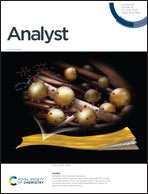Colorimetric sensor arrays for antioxidant recognition based on Co3O4 dual-enzyme activities†
Abstract
Antioxidants are considered as essential compounds for monitoring human health. In this work, a colorimetric sensor array was developed using oxidase-like (OXD) and peroxidase-like (POD) activities of Co3O4 nanoflowers as sensing elements, together with a substrate, 3,3′,5,5′-tetramethylbenzidine dihydrochloride (TMB), as a signal reader to effectively identify different antioxidants. In the presence of Co3O4, colorless TMB can be oxidized into blue oxTMB to different degrees in the presence and absence of H2O2. Interestingly, after the addition of antioxidants, the sensor array showed cross-reactions, and different changes in color and absorbance were observed, as TMB and antioxidants competed for binding. Different colorimetric responses were obtained on the sensor array and identified by linear discriminant analysis (LDA). The LDA result indicated that the sensor array can be used to distinguish 4 antioxidants, namely, dopamine (DA), glutathione (GSH), ascorbic acid (AA), and cysteine (Cys) at seven different concentrations, namely, 10, 20, 30, 50, 100, 200, and 250 nM. Different concentrations of antioxidants and proportions of mixed antioxidants were determined. This demonstrates the potential application of sensor arrays in diagnosis and food monitoring.



 Please wait while we load your content...
Please wait while we load your content...